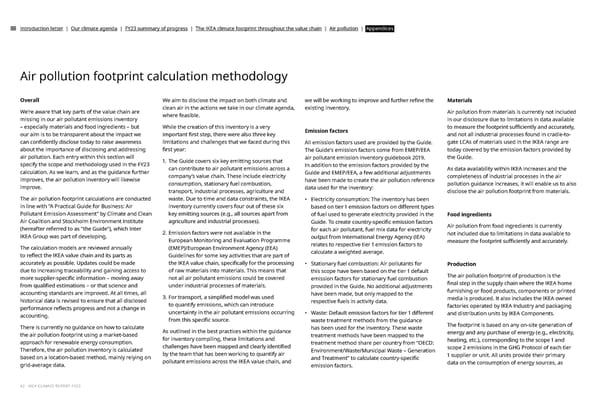Introduction letter | Our climate agenda | FY23 summary of progress | The IKEA climate footprint throughout the value chain | Air pollution | Appendices Air pollution footprint calculation methodology Overall We aim to disclose the impact on both climate and we will be working to improve and further re昀椀ne the Materials We’re aware that key parts of the value chain are clean air in the actions we take in our climate agenda, existing inventory. Air pollution from materials is currently not included missing in our air pollutant emissions inventory where feasible. in our disclosure due to limitations in data available – especially materials and food ingredients – but While the creation of this inventory is a very Emission factors to measure the footprint su昀케ciently and accurately, our aim is to be transparent about the impact we important 昀椀rst step, there were also three key and not all industrial processes found in cradle-to- can con昀椀dently disclose today to raise awareness limitations and challenges that we faced during this All emission factors used are provided by the Guide. gate LCAs of materials used in the IKEA range are about the importance of disclosing and addressing 昀椀rst year: The Guide's emission factors come from EMEP/EEA today covered by the emission factors provided by air pollution. Each entry within this section will 1. The Guide covers six key emitting sources that air pollutant emission inventory guidebook 2019. the Guide. specify the scope and methodology used in the FY23 can contribute to air pollutant emissions across a In addition to the emission factors provided by the As data availability within IKEA increases and the calculation. As we learn, and as the guidance further company’s value chain. These include electricity Guide and EMEP/EEA, a few additional adjustments completeness of industrial processes in the air improves, the air pollution inventory will likewise consumption, stationary fuel combustion, have been made to create the air pollution reference pollution guidance increases, it will enable us to also improve. transport, industrial processes, agriculture and data used for the inventory: disclose the air pollution footprint from materials. The air pollution footprint calculations are conducted waste. Due to time and data constraints, the IKEA • Electricity consumption: The inventory has been in line with “A Practical Guide for Business: Air inventory currently covers four out of these six based on tier 1 emission factors on di昀昀erent types Pollutant Emission Assessment” by Climate and Clean key emitting sources (e.g., all sources apart from of fuel used to generate electricity provided in the Food ingredients Air Coalition and Stockholm Environment Institute agriculture and industrial processes). Guide. To create country-speci昀椀c emission factors Air pollution from food ingredients is currently (hereafter referred to as "the Guide"), which Inter 2. Emission factors were not available in the for each air pollutant, fuel mix data for electricity not included due to limitations in data available to IKEA Group was part of developing. European Monitoring and Evaluation Programme output from International Energy Agency (IEA) relates to respective tier 1 emission factors to measure the footprint su昀케ciently and accurately. The calculation models are reviewed annually (EMEP)/European Environment Agency (EEA) calculate a weighted average. to re昀氀ect the IKEA value chain and its parts as Guidelines for some key activities that are part of accurately as possible. Updates could be made the IKEA value chain, speci昀椀cally for the processing • Stationary fuel combustion: Air pollutants for Production due to increasing traceability and gaining access to of raw materials into materials. This means that this scope have been based on the tier 1 default The air pollution footprint of production is the more supplier-speci昀椀c information – moving away not all air pollutant emissions could be covered emission factors for stationary fuel combustion 昀椀nal step in the supply chain where the IKEA home from quali昀椀ed estimations – or that science and under industrial processes of materials. provided in the Guide. No additional adjustments furnishing or food products, components or printed accounting standards are improved. At all times, all 3. For transport, a simpli昀椀ed model was used have been made, but only mapped to the media is produced. It also includes the IKEA owned historical data is revised to ensure that all disclosed to quantify emissions, which can introduce respective fuels in activity data. factories operated by IKEA Industry and packaging performance re昀氀ects progress and not a change in uncertainty in the air pollutant emissions occurring • Waste: Default emission factors for tier 1 di昀昀erent and distribution units by IKEA Components. accounting. from this speci昀椀c source. waste treatment methods from the guidance The footprint is based on any on-site generation of There is currently no guidance on how to calculate As outlined in the best practices within the guidance has been used for the inventory. These waste the air pollution footprint using a market-based treatment methods have been mapped to the energy and any purchase of energy (e.g., electricity, for inventory compiling, these limitations and approach for renewable energy consumption. treatment method share per country from “OECD: heating, etc.), corresponding to the scope 1 and Therefore, the air pollution inventory is calculated challenges have been mapped and clearly identi昀椀ed Environment/Waste/Municipal Waste – Generation scope 2 emissions in the GHG Protocol of each tier based on a location-based method, mainly relying on by the team that has been working to quantify air 1 supplier or unit. All units provide their primary pollutant emissions across the IKEA value chain, and and Treatment” to calculate country-speci昀椀c data on the consumption of energy sources, as grid-average data. emission factors. 42 - IKEA CLIMATE REPORT FY23
 IKEA CLIMATE Report FY23 Page 41 Page 43
IKEA CLIMATE Report FY23 Page 41 Page 43